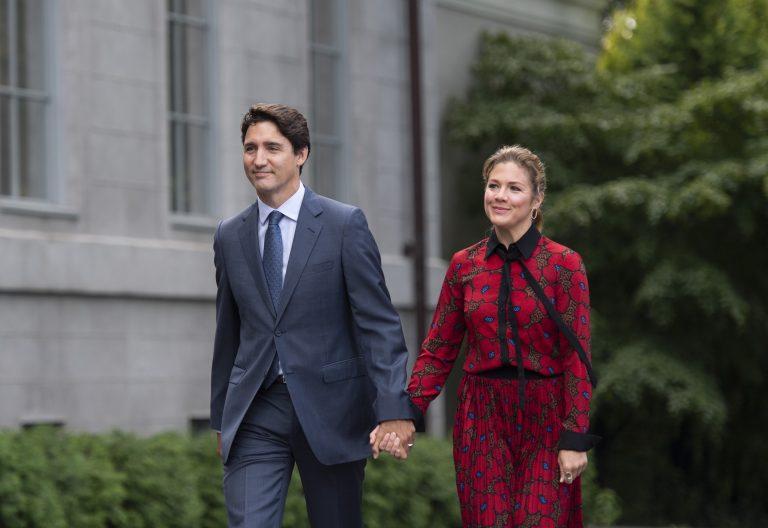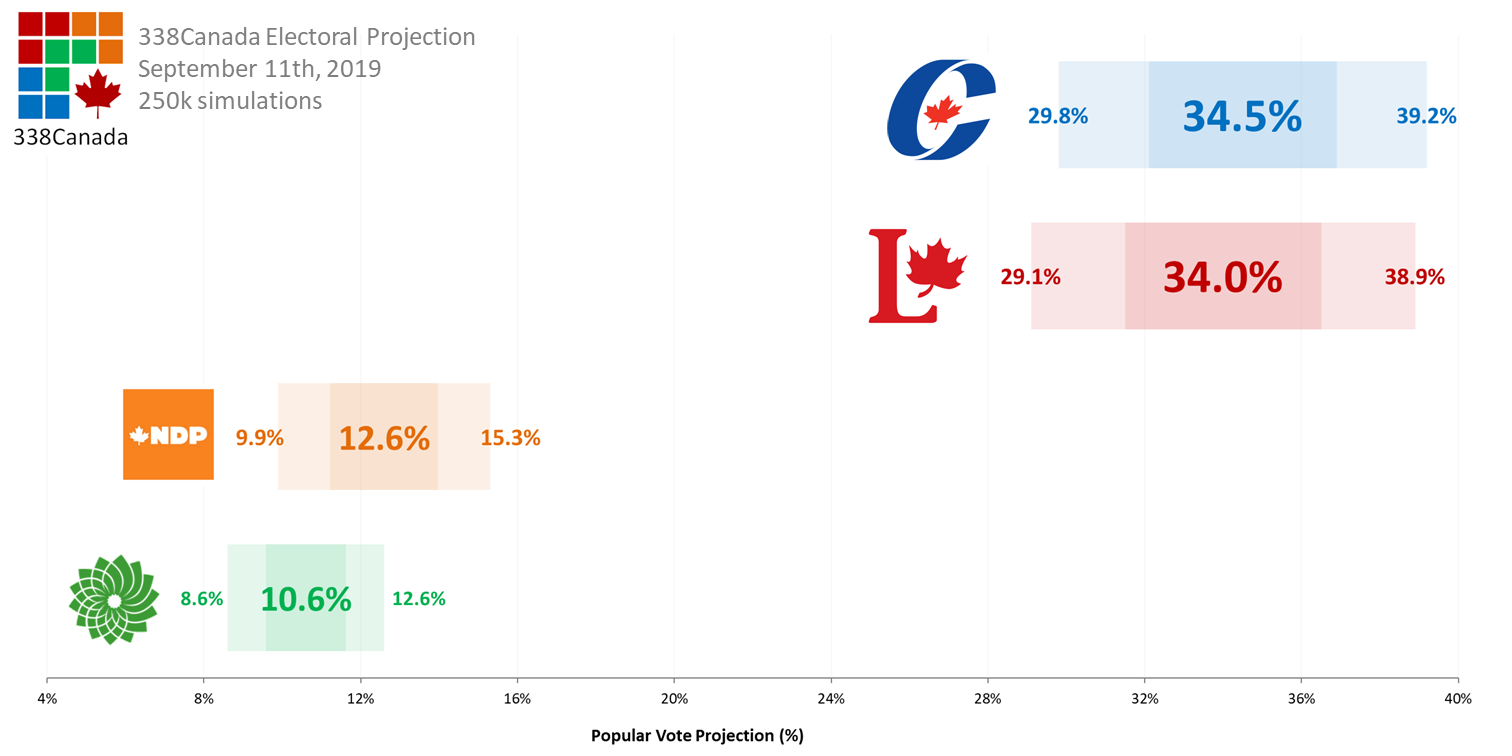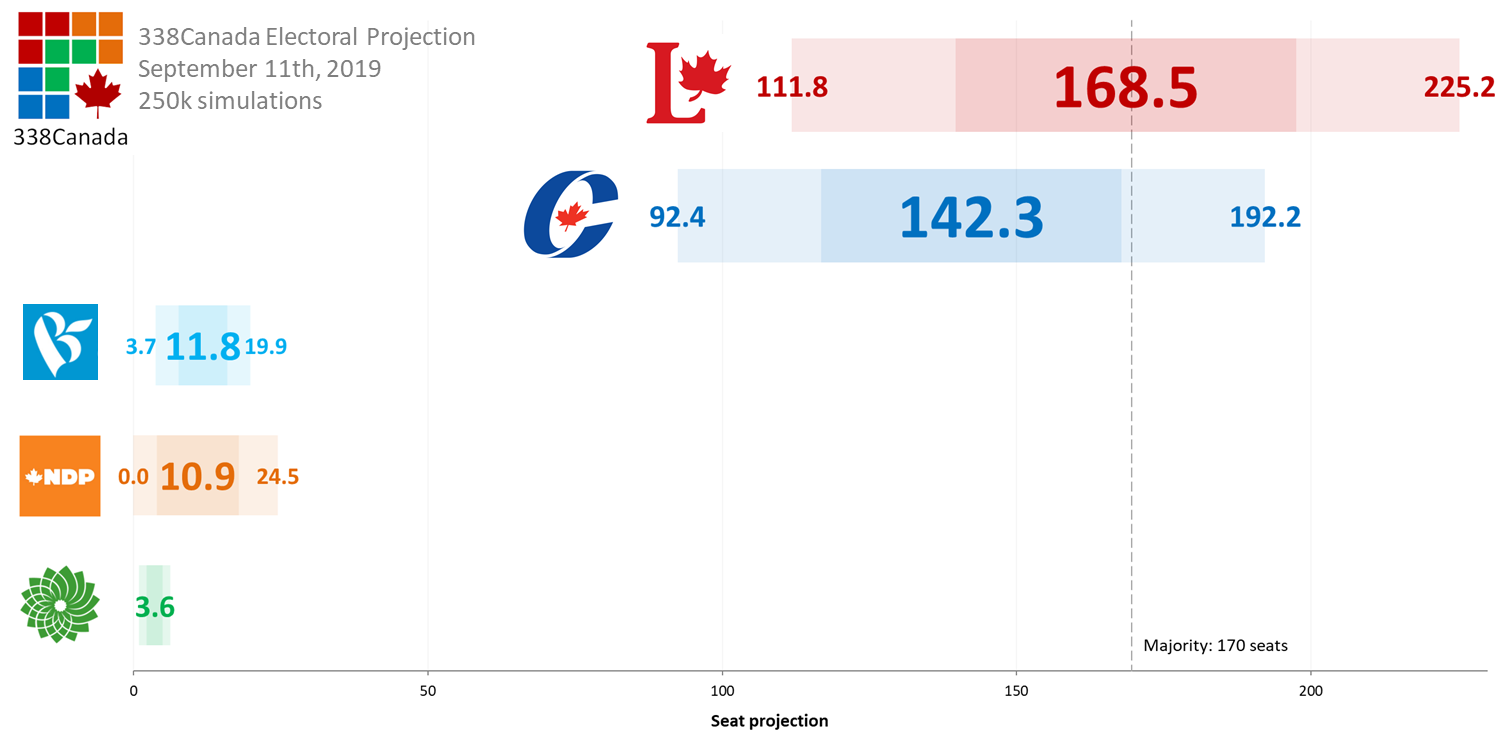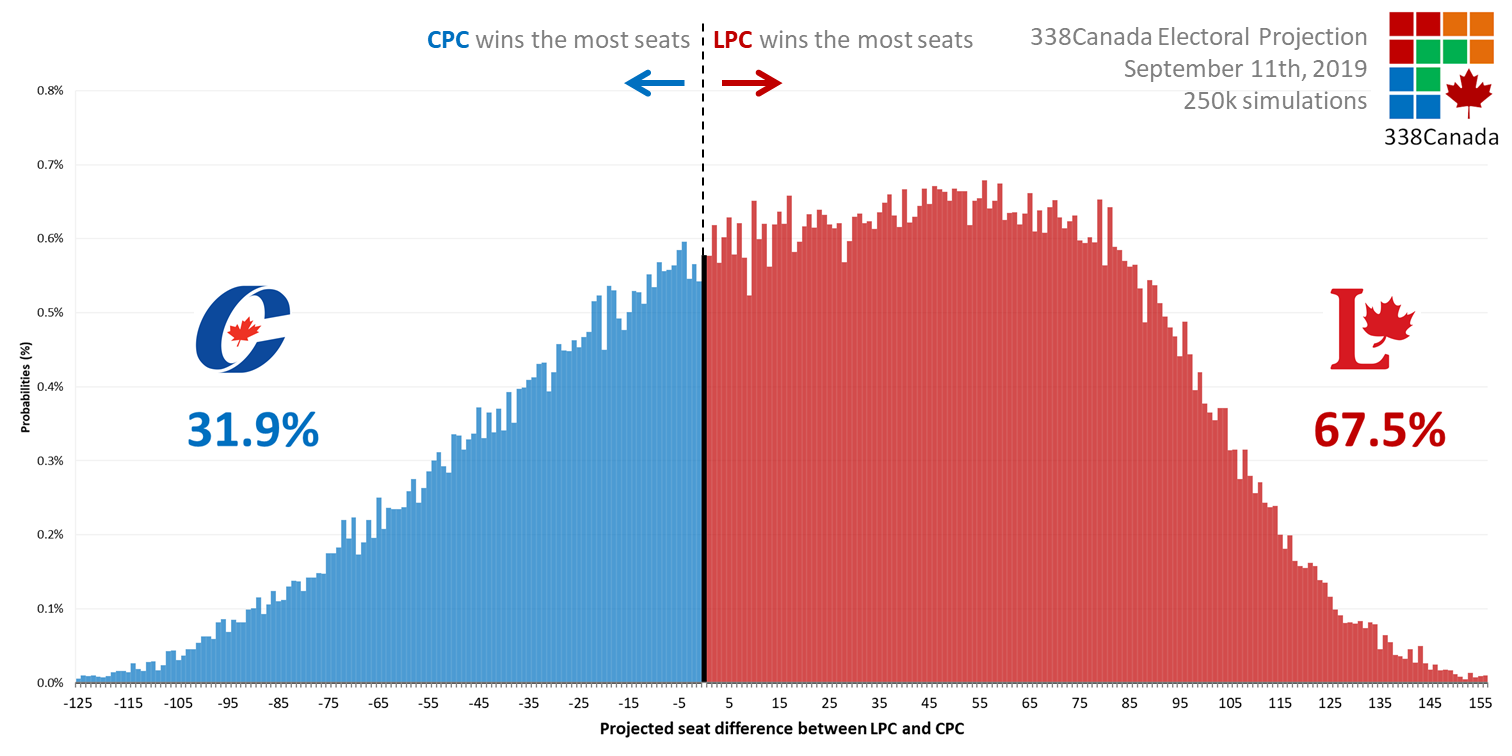338Canada: A Day 1 vote projection shows a Liberal lead and a new NDP low
Philippe J. Fournier: A flurry of new polls are out to mark the start of the federal election campaign. They put the Liberals one seat shy of a majority.

Trudeau arrives at Rideau Hall with his wife Sophie Gregoire Trudeau to meet with Governor General Julie Payette on Sept. 11, 2019 (Justin Tang/CP)
Share
As Justin Trudeau paid a visit to Governor General Julie Payette on Wednesday, a flurry of new polls were released throughout the day—enough to warrant a full updated projection of the race at the starting line. Here is a short recap:
After releasing its latest federal numbers earlier in the week, on Wednesday Mainstreet Research published four riding polls for three Quebec regional newspapers: Sherbrooke (La Tribune), Trois-Rivières (Le Nouvelliste), and Quebec City (Le Soleil). Here are the ridings’ poll results:
- In Trois-Rivières, a town of 140,000 inhabitants halfway between Montreal and Quebec city (which I have affectionately called the Red Deer of Quebec on occasion), incumbent NDP MP Robert Aubin appears to be standing at the bottom of a steep hill for re-election (which would be the case for virtually every Quebec NDP MPs). According to Mainstreet, Aubin is polling in fifth place at only 5 per cent in the district. The Liberals are leading the pack with 36 per cent. The Conservatives take second place with 28 per cent. See Le Nouvelliste‘s article here.
- In the same Le Nouvelliste article, it is revealed that Bloc québécois leader Yves-François Blanchet is trailing in Beloeil-Chambly, a suburban district in the all-important South Shore of Montreal. With a sample size of 825 respondents in the district, Blanchet gets the support of 26 per cent of decided and leaning voters, against 35 per cent for the Liberal challenger. Incumbent NDP MP Matthew Dubé is fifth with only 8 per cent of support.
- In Sherbrooke (Quebec’s fourth largest urban centre), incumbent MP Pierre-Luc Dusseault (yet another NDP MP) is in tough for re-election. According Mainstreet, Dusseault is polling at only 12 per cent in fourth place. The Liberal candidate is pulling away from the pack with 44 per cent support, with the Bloc in a distant second place. Here is the La Tribune article.
- Finally, new numbers in Le Soleil indicate that incumbent Liberal MP Joël Lightbound is leading comfortably in his suburban district of Louis-Hébert (near Quebec City) with 40 per cent. Both the Bloc and the Conservative sit at 20 per cent. Here is the Le Soleil article.
We also add to the 338Canada projection the latest Léger/The Canadian Press poll. Léger’s top line numbers are in line with the recent trends: The Conservatives (35 per cent) are in a virtual tie with the Liberals (34 per cent) on voting intentions. The Greens and NDP are fighting for a distant third place with 11 per cent apiece.
As we have seen with other pollsters lately, Léger’s national and regional numbers do not tell the same story: In Quebec, the Liberals now hold a commanding 15-point lead at 37 per cent. The Conservatives (22 per cent) and the Bloc (21 per cent) are battling for second place. The NDP, after being a force in the province in the past two federal general elections, are polling at a dismal 6 per cent—a level of support that could see the NDP being completely wiped out of Quebec—yes, including the Island of Montreal.
In Ontario, Léger has the Liberals six points ahead of the Conservatives (37 to 31 per cent). Out west, the Conservatives dominate the Prairies by 27 points and Alberta by 46 (!) points. Find the complete Léger report here.
Here are the updated 338Canada popular vote projections:
The Conservatives and Liberals remain in a statistical tie with averages of 34.5 and 34 per cent, respectively. Once again, the NDP loses ground to the main parties and slides to 12.6 per cent—the lowest it’s averaged in the 338Canada model since the tracking began last year.
With leads in Atlantic Canada, Quebec and Ontario (and in a near tie in British Columbia), the Liberals lead the seat projections with an average of 169 seats—only one seat short from the majority threshold:
The Conservatives win an average of 142 seats, by (almost) running the table in Alberta, Saskatchewan, rural B.C. and major parts of Central and Southwestern Ontario.
The Bloc québécois takes an average of 12 seats (with 19 per cent in Quebec). The NDP falls to 11 seats and the Greens, 4 seats.
Nevertheless, since there remains so many close races—especially in the suburbs of Montreal and Toronto, as well as parts of the Lower Mainland—the Liberals only win the most seats in 68 per cent of all simulations. As of this writing, the Liberals are barely 2-to-1 favourites to win a plurality of seats at the House of Commons.
The Conservatives have their work cut out for them: They hold the most safe seats among major parties and dominate two provinces almost entirely. But it is in Eastern Canada that the CPC has to find ways to make gains.
Numbers in Quebec have looked promising in the past months for Andrew Scheer. (Notice that he launched his campaign in the toss up riding of Trois-Rivières?) But his party seems to have peaked too soon in the province. Last spring, Léger measured as much as 30 per cent support in Quebec for the Conservatives—enough to hope for major gains in rural Quebec—but its latest poll has the CPC down to only 22 per cent, tied with the Bloc in the province.
As John Geddes writes in his new Maclean’s article, the Conservatives’ last hopes to win the most seats and defeat Justin Trudeau may lie in the 30 districts of the GTA where both Harper (2011) and Trudeau (2015) fared extremely well in their respective majority victories.
The writ has been dropped/drawn up (or issued, as some scholars have told me was the correct jargon). The 2019 federal campaign has been launched. In the next 40 days, we will follow the numbers to give Canadians an accurate description of their political landscape.
Enjoy the campaign, dear readers.


